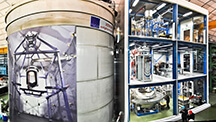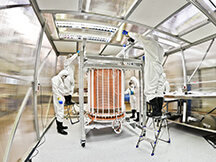Purdue professor part of XENON1T experiment
November 12, 2015
 |
|
The XENON1T water tank, which houses the detector, is shown next to a three-story building that houses supporting infrastructure. (Photo courtesy of the XENON Collaboration) |
WEST LAFAYETTE, Ind. — A detector buried deep beneath a tall mountain, nearly one mile of rock and 16 feet of water could rise to the occasion in the search for dark matter.
The XENON1T detector was inaugurated Nov. 11 at the Gran Sasso Underground Laboratory in Italy, where it may capture signatures of dark matter that flow through the Earth as it moves through space.
The detector is equipped with electronics that can detect even individual electrons and photons generated as particles hit molecules within a stainless steel container of liquid xenon.
To shield the sensitive detector from cosmic radiation that could create background events, it is buried beneath rock and water in the largest underground laboratory in the world.
 |
|
The XENON1T detector is assembled in a clean room. (Photo courtesy of the XENON Collaboration) |
Rafael Lang, an assistant professor in Purdue University's Department of Physics and Astronomy, is part of the international XENON1T collaboration. His team built various calibration systems for the detector, including a plasma fusion neutron generator.
He also was a part of the XENON100 experiment, the first phase of the XENON collaboration.
"The XENON100 experimental results showed an impressive sensitivity, and the XENON1T is 20 times bigger, includes a series of technological improvements and is expected to be 100 times more sensitive," Lang said. "This sensitivity means we can look at every event and no longer need to constrain analysis to only a portion of the data captured. Being able to examine all of the data opens the door to finding evidence of dark matter in an unexpected place or in a form we didn't consider."
The collaboration issued a news release that is available at http://www.purdue.edu/newsroom/
Writer: Elizabeth K. Gardner, 765-494-2081, ekgardner@purdue.edu
Source: Rafael Lang, 765-494-3048, Rafael@purdue.edu
Related Video: https://youtu.be/3ddMfOkyhSg
Related news releases:
Purdue professor featured in 'Through the Wormhole with Morgan Freeman'
A detector shines in search for dark matter

